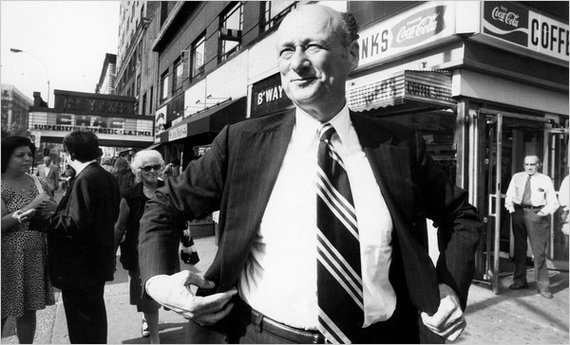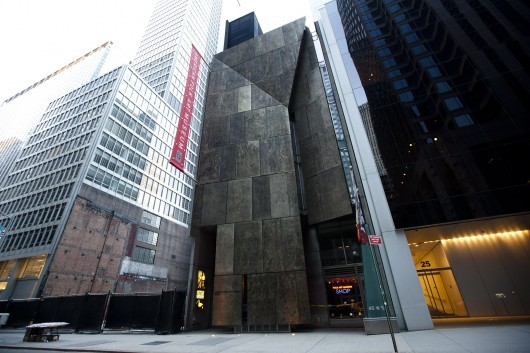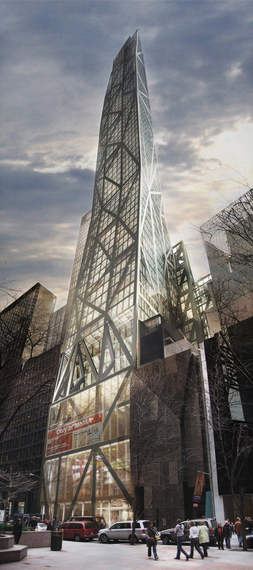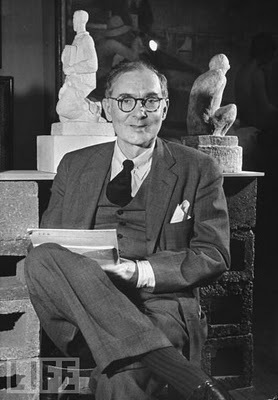Jacqueline Onassis is widely recognized as a preservation pioneer for her leadership in saving Grand Central Terminal and her involvement in the initiative for the Supreme Court ruling in its behalf that set legal precedent for landmark statutes. What is less known are her many other civic forays. She helped to sustain Times Square's lights against what proved to be Mayor Koch's colossally and, in retrospect, risibly misguided effort to zone them out of existence,...
... and fought for the seminal salvaging designation of SOM's Lever House is 1982, when a modernist building then only 30 years old held very little protectionist sway apart from the former First Lady's personal civic vision, as shared by her Municipal Art Society cohorts. The vote by what was then called the Board of Estimate was a crucible act of modernist recognition even as the cultural label of "cap M" Modernism itself was already in historical retreat.
Thirty-two years later, the global preservation organization DOCOMOMO works to safeguard comparable historic modernist lodestones, but demarks its mission's end at 1975; further evidence of the complex theoretical divide between modern and contemporary.
Such a divide seems worth recalling as the Museum of Modern Art decides after careful analysis by its new gallery architects, Diller Scafidio & Renfro, to demolish the 12-year old Museum of American Folk Art building designed by Tod Williams and Billie Tsien. Other than the spirited call for reconsideration by the progressive Architectural League, no dedicated civic or preservationist organization has come to its defense, including the City's official Landmarks Commission.
The Museum's very generous purchase of the building at what was the bottom of the Great Recession real estate market saved the Folk Art client institution from bankruptcy and allowed it a future with collections intact as would have been otherwise impossible. The Modern is to be much commended for this collegial act of eleemosynary benevolence.
That said, MOMA plans to fill in the empty footprint in porous ground floor embrace of the Jean Novel tower above it--another construction made possible by the City's recent shifts in zoning and their radical transformation of midtown Manhattan's height allowances, with a broad swath of 90-story towers under way across the West 50s.
In the spirit perhaps of no good deed goes unpunished, the Museum's present decision to sacrifice the contemporary if not categorically orthodox modernist Tod Williams Billie Tsien Architects Folk Art Museum (ill-conceived operationally as it clearly was) is nonetheless a record of the increasingly blurred narrative of late 20th and early 21st century aesthetic constructs.
It is in this current era, when the fixed and official narrative of modernism itself yields to worthy and, at its best, rigorous post-Post-Modern reconsideration, that design leaders must confront new ideas about what defines the future of the built environment and what preservation record can best kindle measured progress accordingly.
What is called for today is a rigorous and objective discussion about this advocacy gap for protecting recent design excellence and how it can best be filled, whether through public policy or broader non-governmental civic engagement. There are precedents such as the Friends of the Upper East Side's exhibit and catalog entitled Modern Architecture on the Upper East Side/Landmarks of the Future, but broader more inclusive debate merits ignition by local stewards.
This effort would profit from the wisdom and resources of MOMA itself, which proudly boasts America's first department of architecture and design. Its great founder Alfred Barr would surely be the first to concede this necessity even as future values always prove impossible to predict.
In the wake of this difficult decision and with its West 53rd Street extension options now extending to their final phase (there are, after all, limits to density as even enlightened developers would concede) that America's interpretive institutional crucible of the new can play a key role on this dynamic architectural front.
Paul Gunther




